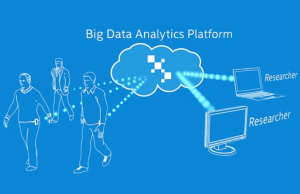Data is collected from Parkinson’s patients via wearable devices, and housed in an open platform for analysis devised at Intel Israel.
When the Michael J. Fox Foundation for Parkinson’s Research and Intel Corporation announced their collaboration on a project to improve research and treatment for Parkinson’s disease, few people noticed that the heart of the collaboration is at Intel Israel. The collaboration depends on information gleaned from a new big-data analytics platform that detects, collects, transmits and analyzes patterns in mobility via wearable devices used by Parkinson’s patients.
Intel’s 100-person advanced analytics team is based at one of the corporation’s five Israeli sites. Department director Itay Yogev picked people from this team to design the infrastructure for the technology, which aims to vastly improve Parkinson’s research as well as the quality of life for participating patients. Yogev explains that retired Intel CEO Andrew Grove, who has Parkinson’s disease, had the idea of putting together Intel expertise with Michael J. Fox Foundation support to push current research efforts far forward. Yogev’s staff started on the project in the summer of 2013.
The technology has since been tested for usability and accuracy at Harvard in Massachusetts, at Mount Sinai Medical Center in New York City and at Sourasky Medical Center in Tel Aviv under chief neurologist Prof. Nir Giladi, a renowned leader in the field of movement disorders. Preliminary results were encouraging enough to broaden the clinical trials to the Netherlands, says Yogev.
“The Netherlands has a national network of Parkinson’s patients, and we are working to connect with a few hundred of them during 2015.”
Transforming diagnosis and treatment
Parkinson’s is a neurodegenerative brain disease second only to Alzheimer’s in worldwide prevalence. Yet nearly 200 years after the disease was first described, the way its effects and progression are measured hasn’t advanced. That information comes solely from doctor visits.
“We work with many focus groups of Parkinson’s patients, and we learned that they see a doctor every six to nine months for a few minutes,” says Yogev.
The potential to collect and analyze data from thousands of individuals on measurable features of Parkinson’s — such as slowness of movement, tremor and sleep quality — could enable researchers to assemble a better picture of the clinical progression of Parkinson’s and track its relationship to molecular changes.
Wearables can unobtrusively gather and transmit objective, experiential data constantly, in real time, to the cloud. That will enable researchers to go from looking at a small number of data points and patient diaries to analyzing hundreds of readings per second from thousands of patients and attaining a critical mass of data to detect patterns and make new discoveries.

Anonymous patient data is aggregated and analyzed for new
insights into Parkinson’s disease. Image courtesy of Intel
“Data science and wearable computing hold the potential to transform our ability to capture and objectively measure patients’ actual experience of disease, with unprecedented implications for Parkinson’s drug development, diagnosis and treatment,” said Michael J. Fox Foundation CEO Todd Sherer.
Helpful for patients, too
Yogev points out that those using the technology also benefit.
“Parkinson’s patients want to really know how they are doing, so we provide the ability to understand the objective measurements of their tremors and activities and, on an even more sophisticated level, help them with insights gleaned from the data.”
For example, the person may see that his or her mobility is better the day after going to bed early. The technology also allows them to set reminders for taking medication. A mobile application enables patients to report their medication intake as well as how they are feeling, allowing researchers to study the effects of medication on motor symptoms via changes detected in sensor data.
The “guts” of the system are designed to be used in conjunction with existing smart watches synched to a smartphone.
“We’re working with commercially available wearables, so the beauty of this is we can support different models,” says Yogev. “The most important thing is to be able to build a data repository with thousands of patients connected 24/7 over many years in a continuous manner.”
“Emerging technologies can not only create a new paradigm for measurement of Parkinson’s but, as more data is made available to the medical community, it may also point to currently unidentified features of the disease that could lead to new areas of research,” added Diane Bryant, senior vice president and general manager of Intel’s Data Center Group. Based in Santa Clara, California, Bryant oversees the advanced analytics department in Israel.
To analyze the volume of data — more than 300 observations per second from each participant – Yogev’s team developed a big-data analytics platform that integrates software components including Cloudera DH, an open-source software platform that collects, stores and manages data. The platform is deployed on a cloud infrastructure optimized on Intel architecture.
The platform could store other types of information such as patient, genome and clinical trial data, and could enable other advanced techniques such as machine learning and graph analytics to deliver more accurate predictive models to researchers.
Data scientist Shahar Cohen, a member of the Intel group working on this project, told participants at a recent artificial-intelligence conference at Israel’s Ariel University that the wearable technology will allow researchers “to better understand how Parkinson’s disease works and what the exact symptoms are.” Cohen explained: “Until now, many aspects of the disease where virtually unknown because of the need for in-depth monitoring of patients. Now, researchers will be able to get a much clearer picture of how the disease is affecting patients.”



















